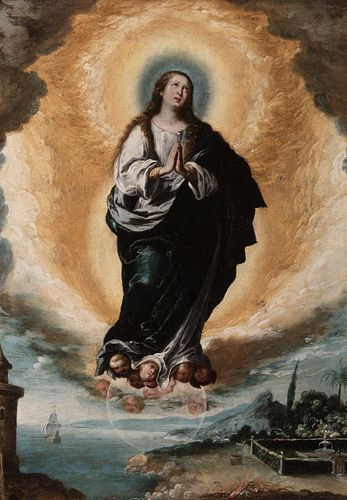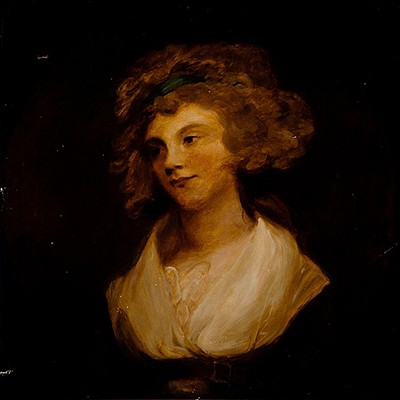PEDRO DE MOYA (Granada, c. 1610- January 15, 1674) "Immaculate". Oil on canvas. Relined.
About Seller
Carrer Aragó 346
Barcelona
Spain
Setdart Subastas was born in 2004 and is currently the first online art auction in Spain with solidity, prestige and reliability guaranteed by our more than 60,000 users. Setdart has a young, dynamic and enterprising team ready to successfully manage the purchase and sale of art works through custom...Read more
Two ways to bid:
- Leave a max absentee bid and the platform will bid on your behalf up to your maximum bid during the live auction.
- Bid live during the auction and your bids will be submitted real-time to the auctioneer.
Bid Increments
| Price | Bid Increment |
|---|---|
| EUR€0 | EUR€10 |
| EUR€200 | EUR€25 |
| EUR€500 | EUR€50 |
| EUR€1,000 | EUR€100 |
| EUR€3,000 | EUR€200 |
| EUR€5,000 | EUR€500 |
| EUR€10,000 | EUR€1,000 |
| EUR€20,000 | EUR€2,000 |
| EUR€50,000 | EUR€5,000 |
About Auction
Nov 25, 2021
Setdart Auction House sofia@setdart.com
- Lot Description
PEDRO DE MOYA (Granada, c. 1610- January 15, 1674) "Immaculate". Oil on canvas. Relined. Presents restorations. Presents on the back old label of the Ibero-American Exposition, Seville, 1929: Written in ink: No. 806; Exhibitor D. Fernando López Cepero; Object: The Conception of P. de Moya; Location: Seville. Bibliography: Iberoamerican Exposition. Pabellón de las Bellas Artes, Seville 1929: Calvo Castellón, A. The architectural backgrounds and the landscape in the Andalusian Baroque painting. Granada, 1982, pp. 307 and 308. Measurements: 49 x 38 cm; 63 x 49.5 cm (frame). Several works from the collection of Fernando López Cepero were included in the Ibero-American exhibition held in Seville in 1929. They were grouped in room V of the Fine Arts Pavilion. In 1982, Professor Calvo Castellón included this painting in the published version of his doctoral thesis: Los fondos arquitectónicos y el paisaje en la pintura barroca andaluza. At that time it still belonged to the López Cepero collection in Seville. In the writing he maintains the traditional attribution to Pedro de Moya and emphasizes that this is the only baroque painter from Granada who paints the Immaculate Conception with a landscape background that includes elements of the Lauretan litanies: the bay, the ship, the hortus conclusus with the well, the palm tree, the cypress. As for the provenance, it is worth mentioning that Fernando López Cepero was the great-grandson of Manuel López Cepero, one of the most important art collectors of the 19th century in Spain. Manuel López Cepero (Jerez de la Frontera, Cádiz, 1778-Sevilla, 1858) was a priest of liberal ideas, writer and politician. A member of the Cortes de Cádiz, he became Dean of the cathedral of Seville and held important political and cultural positions. His collection, installed in the old house of Murillo, had more than a thousand paintings. The image of this Inmaculada is perfectly framed within the Spanish 17th century, marked at a stylistic and iconographic level following the models established in the Baroque. We see Mary dressed in white and blue (symbols of purity and the concepts of truth and eternity, respectively), leaning on the sphere, and a set of vaporous clouds that harmonize with the faces of child angels. It is very interesting to note that under the break of glory in which the Virgin is inscribed, a landscape can be seen in which a maritime view and another of a landscape character can be appreciated, thus demonstrating the power of the Virgin as Queen of Christianity, exercising her power universally. The definitive icnographic image of the Immaculate Conception took shape in the 16th century, apparently in Spain. Following a Valencian tradition, the Jesuit Father Alberro had a vision and described it to the painter Juan de Juanes so that he could capture it as faithfully as possible. It is an evolved iconographic concept, which is sometimes associated with the theme of the Coronation of the Virgin. There is little biographical information about the life of Pedro de Moya, according to the words of Palominio, Pedro de Moya began his training in Seville at the hand of the master Juan del Castillo. It was in that city where he established contact with the painting of Murillo and Alonso Cano, who influenced artistically in the pictorial conception of Pedro de Moya. It is known that he moved to Flanders, due to his military condition, and established contact with the painter Van Dyck, as well as with Rubens. The proximity with Van Dyck has led to think that Pedro de Moya moved to England with the master. It is probable that he returned to Spain in 1641, first in the city of Seville and later in Granada. It is probable that this condition of nomadic life hindered the investigation of his biography, in addition to this characteristic we must add a scarce knowledge of his artistic production, since at present there are few documented works of the master. Aesthetically his painting was defined by a style similar to that of Cano.
Dimensions:
INV Number:
49 x 38 cm; 63 x 49.5 cm (frame).
35256236 - Shipping Info
-
In-house shipping available. Please inquire at admin@setdart.com.
-
- Buyer's Premium



 EUR
EUR CAD
CAD AUD
AUD GBP
GBP MXN
MXN HKD
HKD CNY
CNY MYR
MYR SEK
SEK SGD
SGD CHF
CHF THB
THB

















